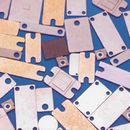Mo50Cu50 heat sink

- Composition: Mo 50%, Cu 50%
- Density: 9.4g/cm3
- Coefficient of Thermal Expansion (10-6/K): 9.8
- Thermal Conductivity (W/mK): 245
- Specific Heat Capacity (J/kgK): 320
- Length: 5mm-300mm
- Width: 5mm-300mm
- Thickness: 0.1mm-5.0mm
Molybdenum Copper high performance composites are fabricated from carefully controlled porous Molybdenum that is vacuum infiltrated with molten copper. This results in a MoCu composite that has high conductivity and a matched low thermal expansion for heat sinks.
Molybdenum copper composites to be used extensively in thermal mounting plates, chip carriers, flanges, and frames for high-powered electronic devices. With the thermal advantages of copper with the very low expansion characteristics of molybdenum, molybdenum copper has properties similar to those of silicone carbide, aluminum oxide, and beryllium oxide. The thermal conductivity and low expansion also make molybdenum copper alloy an excellent choice even for extremely dense circuits.
It is a composite of molybdenum and copper. By controlling the content of molybdenum, we can design its coefficient of thermal expansion (CTE), matching that of the materials, such as Ceramics (Al2O3, BeO), Semiconductors (Si), Kovar, etc.
Advantages: High thermal conductivity, Excellent hermetic, Excellent size control, surface finish and flatness, Semi-finished or finished (Ni/Au plated) products available
The data of copper molybdenum sheet
|
Ingredients Name |
CAS Number |
% Weight |
| Molybdenum | 7439-98-7 | 50-85 |
| Copper | 7440-50-8 | 15-50 |
|
Composition |
Mo 85% |
Mo 70% |
Mo 50% |
| Density (g/cm3) |
10.0 | 9.6 | 9.5 |
| Coefficient of Thermal Expansion (10-6/K) |
6.3 | 7.5 | 9.8 |
| Thermal Conductivity (W/mK) |
160 | 190 | 245 |
| Specific Heat Capacity (J/kgK) |
275 | 300 | 320 |
| Young’s Modulus (Gpa) |
275 | 220 | 170 |
| Specific Electrical Resistance (uΩm) |
0.044 | 0.035 | 0.027 |
| Vickers Hardness (HV10) |
235 | 175 | 145 |
Copyright©2001 - 2011 CTIA E-biz Center All Rights Reserved
